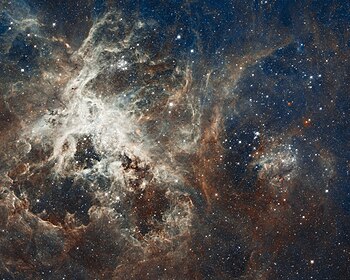Talk:Tarantula Nebula
| This It is of interest to the following WikiProjects: | ||||||||||||||
| ||||||||||||||
Tarantula Nebula
[edit]this dose not have a lot of info
R136a wrong reference
[edit]The reference to R136a should be to R136, which is the term used in the cited reference #3. This is doubly unfortunate since the information in article R136a also applies only to R136. R136 is called a super star cluster in [1].
This reference [2] explains how R136 is the centre of 30 Doradus (another name for the Tarantula Nebula) and R136a is one of several components of R136.
I don't think a separate article on the component R136a is warranted, rather that R136 could mention it with references.
So I've gone ahead and changed the reference. Puzl bustr (talk) 12:33, 25 October 2009 (UTC)
Removed overlapping text and piccy
[edit]I cut-and-pasted the pictures, starting from the overlapping one, to put them after the overlapping text. Puzl bustr (talk) 16:45, 28 October 2009 (UTC)
Corrected diameter reference
[edit]I corrected the diameter reference for R136 using a more precise reference. The previously given diameter was that of R136a, the central blob. I think the original reference, which is much more general and not talking just about R136, actually made a mistake, confusing R136 and R136a, as mentioned above. The R136 article has a diagram giving this distance also. The reference I gave stated that 8" was 2 parsec in the picture, which was 35" by 35", hence (2 parsec being about 7 light years) the diameter I gave was 35 light years. It's only approximate, of course.Puzl bustr (talk) 13:55, 22 November 2009 (UTC)
VFTS 682
[edit]With VFTS 682 determined to have 150 solar masses, it'd be a good time to expand the info here , and/or, create an article about this star.
http://www.spacedaily.com/reports/ESO_VLT_Finds_a_Brilliant_but_Solitary_Superstar_999.html
65.94.44.141 (talk) 16:53, 29 May 2011 (UTC)
Properties box: diameter of nebula
[edit]While I'm aware that the diameter of nebulas are somewhat difficult to define, different values should not be off by as much as a factor of two or more. The radius is given as 300ly, the distance as 160kly. An object with the diameter of 600ly at that distance has apparent dimensions of 13 arcminutes. Yet the given apparent dimensions are larger by a factor of two to three. So either the apparent dimensions, or the radius, as given, is wrong. Somebody can look into this?WikiPidi (talk) 08:54, 19 October 2018 (UTC)
Featured picture scheduled for POTD
[edit]Hello! This is to let editors know that File:30 Doradus, Tarantula Nebula.jpg, a featured picture used in this article, has been selected as the English Wikipedia's picture of the day (POTD) for May 14, 2024. A preview of the POTD is displayed below and can be edited at Template:POTD/2024-05-14. For the greater benefit of readers, any potential improvements or maintenance that could benefit the quality of this article should be done before its scheduled appearance on the Main Page. If you have any concerns, please place a message at Wikipedia talk:Picture of the day. Thank you! — Amakuru (talk) 14:56, 10 May 2024 (UTC)

|
The Tarantula Nebula, also known as 30 Doradus, is a large H II region in the Large Magellanic Cloud (LMC). It is one of the largest H II regions in the Local Group, with an estimated diameter around 650 to 1860 light years. It is around 160,000 light-years from Earth and has apparent magnitude of 8. The Tarantula Nebula was first observed by Nicolas-Louis de Lacaille during an expedition to the Cape of Good Hope between 1751 and 1753. This high-resolution photograph was taken by the Hubble Space Telescope and shows the star-forming region of Tarantula Nebula with the R136 super star cluster at its center. Photograph credit: NASA, ESA, Space Telescope Science Institute
Recently featured:
|
NED
[edit]The Nasa Extragalactic Database (NED) only gives 0.29 kiloparsecs (946 light years) in diameter for the Tarantula Nebula. Is this measurement accurate? Atlantlc27Lol (talk) 22:34, 15 December 2024 (UTC)
- Start-Class level-5 vital articles
- Wikipedia level-5 vital articles in Physical sciences
- Start-Class vital articles in Physical sciences
- Start-Class Astronomy articles
- Mid-importance Astronomy articles
- Start-Class Astronomy articles of Mid-importance
- Start-Class Astronomical objects articles
- Pages within the scope of WikiProject Astronomical objects (WP Astronomy Banner)


